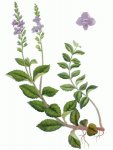Veronica - veronica l.
Family Scallopiaceae - Scrophulariaceae
Botanical characteristics. Perennial herbaceous plant. Rhizome creeping. Stem erect, pubescent or bare. Leaves are obovate-lengthened-lanceolate and narrow. The flowers are axillary / assembled into a dense long terminal brush. Corolla white, blue or purple, depending on the species. Fruit is a box. Blossoms in June - July, fructifies in July - August.
There are several species. The most common and curative are:
- Veronica officinalis - V. officinalis L. It grows in forests, along roadsides, in thickets of bushes. The plant is densely pubescent. Leaves obovate, at the apex short-pointed or blunt, edentate at the margin, narrowed at the base in a short petiole. Flowers are light purple. The capsule is oval.
- Veronica long-leaved - V. longifolia L. It grows in meadows, fringes. Stem erect, slightly branched at the top. Leaves short-petioled, in whorls, ovate-lanceolate, with a rounded base, sharply edged along the margin. The flowers are bluish-lilac or blue. The capsule is oval.
Used parts of the plant. Medicinal raw materials are roots, fruits, aerial parts, collected in the usual way.
All kinds of veronics are used in medicine, but more often they use veronica medicinal and long-leaved, which are considered more curative. All the above-described species are similar in chemical composition, can be used similarly.
Chemical composition. All parts of the plant contain iridoids, saponins, phenolcarbonic acids, carbohydrates and related compounds, cardenolides, coumarins, alkaloids, flavonoids, steroids, organic acids, tannins, anthocyanins, fatty and essential oils, vitamins, aromatic compounds.
Application. In folk medicine in the form of infusions and decoctions of the aerial part, veronica is used for acute respiratory infections, headache, pulmonary tuberculosis, bronchial asthma, which is confirmed by clinical trials, eye, kidney, bladder, liver, biliary tract diseases, inflammatory diseases of the gastrointestinal Tract, diarrhea, rickets, rheumatism, gout, bronchitis, hypertension, angina, skin diseases (eczema, diathesis, scabies, furunculosis), as an analgesic and antibacterial agent.
In practical medicine, Veronica is used in diseases of the respiratory tract, gastritis, enterocolitis; In dentistry with periodontal disease and stomatitis.
In the experiment, veronica drugs have a bronchodilator effect, relax the smooth muscles of the intestine, stimulate the heart, increase urination, have antibacterial and antifungal properties.
In Tibetan medicine, the roots of Veronica long-leaved and Daurian are used for hepatitis, gastroenteritis, endometritis, cardiovascular diseases; In Chinese - Veronica Daurian is used as a hemostatic, antipyretic, wound-healing agent; In the Mongolian - the decoction of the aboveground part is drunk with diseases of the gastrointestinal tract, hyperhidrosis of the feet.
Fresh juice of a flowering plant and infusions of fresh shoots in Azerbaijan are used in the treatment of tumors, with inflammatory phenomena after childbirth. Veronica flowers have found application in homeopathy for bronchitis, cystitis, chronic ulcers and wounds.
Preparation
- For broth take 15 g of roots, pour 200 mg of boiling water, insist on a water bath for 30 minutes, cool 10 minutes, filter. Take 1 tbsp. Spoon 3-4 times a day.
- For infusion of 20 g of leaves and flowers, pour 200 ml of boiling water, insist 15 minutes in a water bath, cool 45 minutes, filter. Take 2 tbsp. Spoon 3 times a day.





Comments
Commenting on, remember that the content and tone of your message can hurt the feelings of real people, show respect and tolerance to your interlocutors even if you do not share their opinion, your behavior in the conditions of freedom of expression and anonymity provided by the Internet, changes Not only virtual, but also the real world. All comments are hidden from the index, spam is controlled.